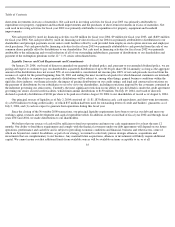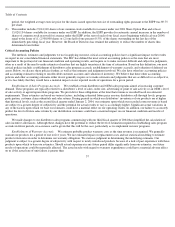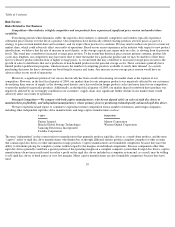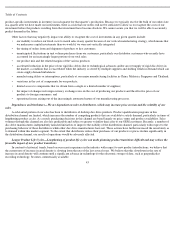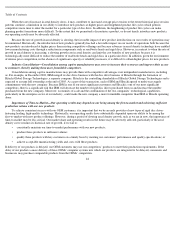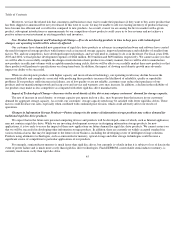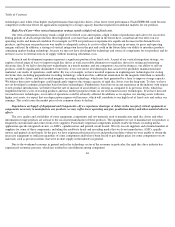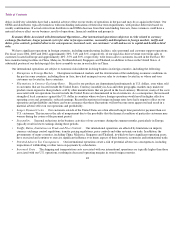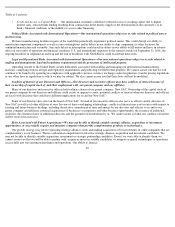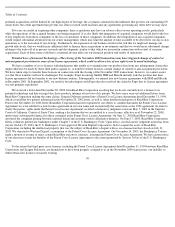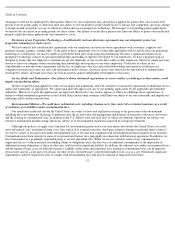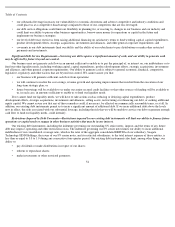Seagate 2003 Annual Report Download - page 46
Download and view the complete annual report
Please find page 46 of the 2003 Seagate annual report below. You can navigate through the pages in the report by either clicking on the pages listed below, or by using the keyword search tool below to find specific information within the annual report.
Table of Contents
Moreover, we face the related risk that consumers and businesses may wait to make their purchases if they want to buy a new product that
has been shipped or announced but not yet released. If this were to occur, we may be unable to sell our existing inventory of products that may
have become less efficient and cost effective compared to new products. As a result, even if we are among the first-to-market with a given
product, subsequent introductions or announcements by our competitors of new products could cause us to lose revenue and not achieve a
positive return on our investment in existing products and inventory.
New Product Development and Technological Change—If we do not develop products in time to keep pace with technological
changes, our operating results will be adversely affected.
Our customers have demanded new generations of rigid disc drive products as advances in computer hardware and software have created
the need for improved storage products with features such as increased storage capacity, improved performance and reliability of smaller form
factors. We, and our competitors, have developed improved products, and we will need to continue to do so in the future. For fiscal years 2004,
2003 and 2002, we had product development expenses of $666 million, $670 million and $698 million, respectively. We cannot assure you that
we will be able to successfully complete the design or introduction of new products in a timely manner, that we will be able to manufacture
new products in sufficient volumes with acceptable manufacturing yields, that we will be able to successfully market these new products or that
these products will perform to specifications on a long-term basis. In addition, the impact of slowing areal density growth may adversely
impact our ability to be successful.
When we develop new products with higher capacity and more advanced technology, our operating results may decline because the
increased difficulty and complexity associated with producing these products increases the likelihood of reliability, quality or operability
problems. If our products suffer increases in failures, are of low quality or are not reliable, customers may reduce their purchases of our
products and our manufacturing rework and scrap costs and service and warranty costs may increase. In addition, a decline in the reliability of
our products may make us less competitive as compared with other rigid disc drive manufacturers.
Impact of Technological Change—Increases in the areal density of disc drives may outpace customers’ demand for storage capacity.
The rate of increase in areal density, or storage capacity per square inch on a disc, may be greater than the increase in our customers’
demand for aggregate storage capacity. As a result, our customers’ storage capacity needs may be satisfied with fewer rigid disc drives. These
factors could decrease our sales, especially when combined with continued price erosion, which could adversely affect our results of
operations.
Changes in Information Storage Products—Future changes in the nature of information storage products may reduce demand for
traditional rigid disc drive products.
We expect that in the future new personal computing devices and products will be developed, some of which, such as Internet appliances,
may not contain a rigid disc drive. While we are investing development resources in designing information storage products for new
applications, it is too early to assess the impact of these new applications on future demand for rigid disc drive products. We cannot assure you
that we will be successful in developing other information storage products. In addition, there are currently no widely accepted standards in
various technical areas that may be important to the future of our business, including the developing sector of intelligent storage solutions.
Products using alternative technologies, such as semiconductor memory, optical storage and other storage technologies could become a
significant source of competition to particular applications of our products.
For example, semiconductor memory is much faster than rigid disc drives, but currently is volatile in that it is subject to loss of data in the
event of power failure and is much more costly than rigid disc drive technologies. Flash EEPROM, a nonvolatile semiconductor memory, is
currently much more costly than rigid disc drive
45


